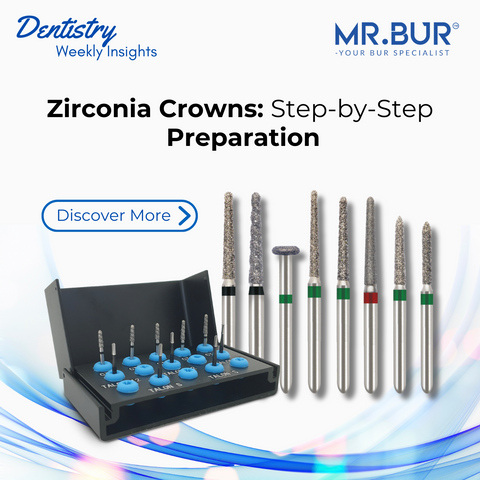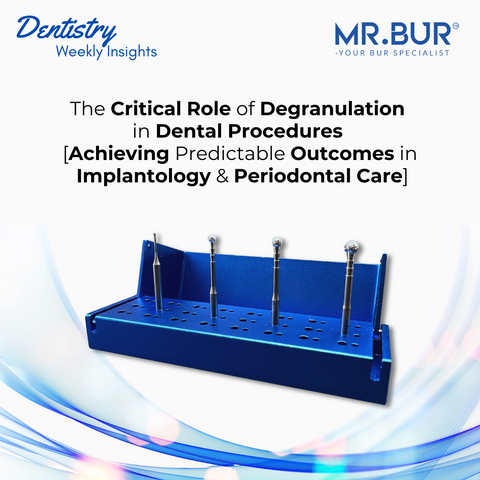Zirconia crowns have gained widespread popularity in modern dentistry for their strength, durability, and aesthetic appeal. However, these same attributes make them challenging to remove when necessary. Understanding the correct removal techniques is essential to avoid damaging the underlying tooth structure and ensuring the effectiveness of dental bur. This guide outlines the best practices for zirconia crown removal, with tips to avoid common mistakes and guidance on selecting the right tools.
What You'll Learn in This Guide:
- The key areas of a zirconia crown that need attention during removal
- Why the interproximal area should be avoided
- Step-by-step instructions for cutting the buccal and occlusal surfaces
- Recommended tools and techniques to ensure safe and efficient removal
Based on feedback from Mr. Bur's clients, using the right tools and following precise techniques can significantly reduce the risk of complications during zirconia crown removal. Read on to discover how to perform this procedure correctly and efficiently.
Understanding the Anatomy of a Zirconia Crown
Zirconia crowns are renowned for their durability because they are made from one of the strongest ceramic materials used in dentistry. This strength, while beneficial for longevity, also makes these crowns tough to cut through during removal. The crown covers various parts of the tooth, including the buccal, occlusal, and interproximal surfaces. Each area requires careful attention during the removal process.
Critical Areas of the Crown
- Buccal Surface: The outer surface facing the cheeks or lips, often the first area targeted for cutting during removal.
- Occlusal Surface: The top surface of the tooth used for chewing, which also needs to be addressed for complete crown removal.
- Interproximal Areas: The spaces between adjacent teeth, which should generally be avoided when cutting to prevent damage to neighboring teeth.
Why Avoid Cutting the Interproximal Area?
Risk of Damage to Adjacent Teeth
The interproximal area is located between the crown and the adjacent teeth. Cutting in this area poses a high risk of accidentally damaging the neighboring teeth, which could lead to further complications and additional treatments. It is essential to avoid cutting this area to preserve the integrity of the adjacent teeth.
Challenges with Low Torque Handpieces
Another critical reason to avoid the interproximal area is the challenge posed by low torque handpieces. These tools often lack the necessary power to cut effectively in tight spaces. The bur can easily become stuck between the crown and the adjacent tooth, causing it to stall and making the cutting process more time-consuming and less effective. Most dentists naturally tend to apply more pressure in these situations, thinking it will speed up the process, but with low torque handpieces, this approach is counterproductive and can cause the bur to stop spinning altogether.
The Correct Approach: Cutting the Buccal and Occlusal Surfaces
When removing zirconia crowns, it is advisable to cut the buccal and occlusal surfaces rather than the interproximal areas for several reasons. First, these surfaces are more accessible, allowing for better control and precision during the cutting process. Second, cutting the buccal and occlusal surfaces minimizes the risk of damaging adjacent teeth and soft tissues. Additionally, focusing on these areas helps to avoid issues associated with low-torque handpieces, as these surfaces are less likely to cause the bur to stall.
Mr. Bur’s crown cutting burs are highly efficient, requiring only 1 minute to cut through a 1mm thick crown. However, some patients may opt to save money by removing a single crown instead of the entire crown bridge. This often necessitates cutting through the interproximal area. While this approach may seem cost-effective, it presents challenges. The interproximal area is typically thicker than 1mm, which can reduce the effectiveness of the bur, especially when using a handpiece with lower torque. Consequently, this method is not ideal, as it can lead to increased cutting time and potential complications.
Step-by-Step Guide to Zirconia Crown Removal
1. Initial Assessment
Begin with a thorough assessment of the crown and the surrounding structures. Evaluate the crown's fit, the condition of the underlying tooth, and any potential challenges that may arise during the removal process. For a detailed understanding of how to prepare zirconia crowns properly, you can refer to our comprehensive guide on Zirconia Crowns: Step-by-Step Preparation.
2. Tool Selection
Choosing the right tools is crucial for efficient and safe zirconia crown removal. Mr. Bur’s Crown Cutter Kit is specifically designed for this purpose and includes:
- CT-1 (Hybrid Twister Super Coarse): Ideal for the initial sectioning of the zirconia crown. The twister design enhances cutting efficiency through tough zirconia.
- CT-2 (Hybrid Twister Super Coarse): Used alongside CT-1, this bur allows for deeper, more precise cuts.
- 2158 (Transmetal Carbide): Perfect for the final sectioning, this bur cuts through the toughest materials while preserving the underlying tooth structure.
3. Buccal Surface Cutting
Begin by making an initial cut on the buccal surface using the CT-1 bur. This area provides the most direct access and allows you to create a controlled cut without risking damage to adjacent teeth. Ensure that the handpiece is positioned correctly, and maintain a steady flow of water to cool the bur and prevent overheating.
If you're curious about how long zirconia crowns last, our article on How Long Do Zirconia Crowns Really Last? Discover the Truth! provides valuable insights into their durability.
4. Occlusal Surface Cutting
After completing the buccal cut, move on to the occlusal surface. Use the CT-2 bur to make deeper cuts into the crown, following the natural contours of the tooth. The goal here is to create a channel that weakens the crown’s structure, facilitating easier removal. Remember to let the bur do the work—apply minimal pressure to prevent stalling.
5. Avoiding Interproximal Cuts
As previously mentioned, avoid cutting the interproximal area to prevent potential complications. Instead, focus on the buccal and occlusal surfaces, where you can achieve better control and efficiency.
Common Pitfalls in Zirconia Crown Removal
Over-Pressuring the Bur
One of the most common mistakes during zirconia crown removal is applying too much pressure on the bur. This is particularly problematic with low torque handpieces, as it can cause the bur to stop spinning, prolonging the procedure and potentially leading to hand fatigue. Instead, allow the bur to do the work, moving it steadily and maintaining a consistent angle.
Inadequate Cooling
Another potential pitfall is inadequate cooling. Overheating the bur and crown can damage both the bur and the underlying tooth structure. Always ensure that the water spray is functioning correctly and is directed at the bur to keep it cool throughout the procedure.
User Guidelines for Optimal Performance
To maximize the effectiveness of the dental burs, follow these guidelines:
- Material Efficiency: Mr. Bur’s dental burs excel in cutting through zirconia and porcelain, though they may operate slightly slower on metal due to its hardness. Despite this, they consistently outperform many other burs available on the market.
- Handpiece Requirements: Use a big head handpiece for better torque power. This ensures that the burs can cut through the zirconia efficiently without stalling.
- Water Spray Condition: Always check that the water spray is properly directed at the bur to prevent overheating.
- Cutting Technique: Always cut on the buccal and occlusal surfaces, avoiding the interproximal areas.
- Pressure Management: Remember, let the bur do the job. Avoid applying excessive pressure, which can cause the bur to stop spinning and prolong the procedure.
- Movement Control: Keep the bur moving up and down with controlled angles to prevent slippage and ensure a smooth cut.
Wrapping Up: The Correct Approach to Zirconia Crown Removal
Successfully removing a zirconia crown requires the right tools, precise technique, and a thorough understanding of the crown's anatomy. By focusing on the buccal and occlusal surfaces and avoiding the interproximal areas, dentists can reduce the risk of complications and complete the procedure more efficiently. The Crown Cutter Kit from Mr. Bur, with its specialized burs like CT-1, CT-2, and 2158, provides the perfect solution for zirconia crown removal, ensuring that dental professionals can deliver the best possible outcomes for their patients.
Thinking about your next zirconia crown removal? What challenges have you faced with zirconia crowns? Ensure you're equipped with the best tools and techniques by subscribing to our updates or getting your Crown Cutter Kit from Mr. Bur today!
Diamond Burs, Carbide Burs, Surgical & Lab Use Burs, Endodontic burs, IPR Kit, Crown Cutting Kit, Gingivectomy Kit, Root Planning Kit, Orthodontic Kit, Composite Polishers, High Speed Burs, Low Speed Burs









